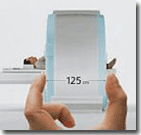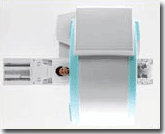
MRI

Magnetic resonance imaging (MRI) is a noninvasive medical test that helps physicians diagnose and treat medical conditions.
MR imaging uses a powerful magnetic field, radio frequency pulses and a computer to produce detailed pictures of organs, soft tissues, bone and virtually all other internal body structures. The images can then be examined on a computer monitor, printed or copied to CD. MRI does not use ionizing radiation (x-rays).
Detailed MR images allow physicians to better evaluate parts of the body and certain diseases that may not be assessed adequately with other imaging methods such as x-ray, ultrasound or computed tomography (also called CT or CAT scanning).
What are some common uses of MRI?
MR imaging of the body is performed to evaluate:
- Brain, inflammatory or infectious lesion, arterial and venous vascular anomalies, tumor
- Spine, herniated disc, inflammatory or infectious lesion, tumor
- Joints, like the knee, shoulder, ankle, feet, hand, wrist, elbow to rule out tear (meniscus or ligament)
- Organs of the chest, abdomen and pelvis—including the heart, liver, biliary tract, kidney, spleen, and pancreas and adrenal glands.
- Pelvic organs including the reproductive organs in the male (prostate and testicles) and the female (uterus, cervix and ovaries).
- Pelvic and hip bones.
- blood vessels (MR Angiography), stenosis, aneurysm
- breasts, implants (r/o leak) or cancer (r/o tumor, controlateral cancer, etc)
What does MRI equipment look like?
The traditional MRI unit is a large cylinder-shaped tube surrounded by a circular magnet. The patient lies on a moveable examination table that slides into the center of the magnet.
Some MRI units, called short-bore systems, are designed so that the magnet does not completely surround you. The computer workstation that processes the imaging information and the scanner are located in separate rooms.
At ViaMedica we have the latest technology. Our Open bore MRI has an opening of 70cm (more than 2 feet) instead of the standard 60cm. The head-in, feet-out design, the bigger opening and the shorter length (125cm instead of 250cm) will reduce the feeling of claustrophobia. Our machine can accommodate patients up to 204 kgs (450lbs) as well as children.

 At ViaMedica Medical Center our state of the art equipment comprises the revolutionary Siemens Espree MRI (1.5T) which offers exceptional image quality and patient comfort. In particular claustrophobic or anxious patients are more relaxed throughout their examination.
At ViaMedica Medical Center our state of the art equipment comprises the revolutionary Siemens Espree MRI (1.5T) which offers exceptional image quality and patient comfort. In particular claustrophobic or anxious patients are more relaxed throughout their examination.
How does MRI work?
Unlike conventional x-ray examinations and computed tomography (CT) scans, MRI does not depend on radiation. Instead, while in the magnet, radio waves redirect the axes of spinning protons, which are the nuclei of hydrogen atoms, in a strong magnetic field.
The magnetic field is produced by passing an electric current through wire coils in most MRI units. Other coils, located in the machine and in some cases, placed around the part of the body being imaged, send and receive radio waves, producing signals that are detected by the coils.
A computer then processes the signals and generates a series of images each of which shows a thin slice of the body. The images can then be studied from different angles by the interpreting physician.
Overall, the differentiation of abnormal (diseased) tissue from normal tissues is often easier with MRI than with other imaging modalities such as x-ray, CT and ultrasound.
How is an MRI exam performed?
MRI examinations may be performed on outpatients or inpatients. A specialized technician will perform your exam. You will have to get changed and you will have to remove all your jewelry before having your exam. We will provide you a locker. You will have to fill out a questionnaire to make sure you don't have any metal in your body (i.e. pacemaker).
You will be positioned on the moveable examination table. Straps and bolsters may be used to help you stay still and maintain the correct position during imaging. The technologist will give you a panic button in case of emergency and you will provide you with headphones (with music) or earplugs.
Small devices that contain coils capable of sending and receiving radio waves may be placed around or adjacent to the area of the body being studied.
If a contrast material will be used in the MRI exam, a nurse or technologist will insert an intravenous (IV) line into a vein in your hand or arm. A saline solution will drip through the IV to prevent blockage of the IV line until the contrast material is injected.
You will be moved into the magnet of the MRI unit and the technologist will leave the room while the MRI examination is performed.
If a contrast material is used during the examination, it will be injected into the intravenous line (IV) after an initial series of scans. Additional series of images will be taken following the injection.
When the examination is completed, you may be asked to wait until the technologist checks the images in case additional images are needed.
Your intravenous line will be removed.
MRI exams generally include multiple runs (sequences), some of which may last several minutes.
The entire examination is usually completed within 45 minutes.
The results of the examination will be sent to your physician within 3 days.
What will I experience during and after an MRI exam?
Most MRI exams are painless.
Some patients, however, find it uncomfortable to remain still during MR imaging. Others experience a sense of being closed-in (claustrophobia). Therefore, sedation can be arranged for those patients who anticipate anxiety, but fewer than one in 20 require it.
It is normal for the area of your body being imaged to feel slightly warm, but if this bothers you, notify the radiologist or technologist. It is important that you remain perfectly still while the images are being recorded, which is typically only a few seconds to a few minutes at a time. For some types of exams, you may be asked to hold your breath. You will know when images are being recorded because you will hear tapping or thumping sounds when the coils that generate the radiofrequency pulses are activated. You will be able to relax between imaging sequences, but will be asked to maintain your position as much as possible.
You will be alone in the exam room during the MR imaging, however, the technologist will be able to see, hear and speak with you at all times using a two-way intercom. ViaMedica allows a friend or parent to stay in the room.
You may be offered or you may request earplugs to reduce the noise of the MRI scanner, which produces loud thumping and humming noises during imaging. MRI scanners are air-conditioned and well-lit. Our scanners have music to help you pass the time.
Some MRI examinations may require the patient to receive an injection of contrast into the bloodstream. The radiologist or technologist may ask if you have allergies of any kind, such as an allergy to iodine or x-ray contrast material, drugs, food, the environment, or asthma. However, the contrast material used for an MRI exam, called gadolinium, does not contain iodine and is less likely to cause an allergic reaction.
When the contrast material is injected, it is normal to feel coolness and flushing for a minute or two. The intravenous needle may cause you some discomfort when it is inserted, and once it is removed you may experience some bruising. There is also a very small chance of skin irritation at the site of the IV tube insertion.
If you have not been sedated, no recovery period is necessary. You may resume your usual activities and normal diet immediately after the exam. A few patients experience side effects from the contrast material, including nausea and local pain. Very rarely, patients are allergic to the contrast material and experience hives, itchy eyes or other reactions.
The radiologist should also know if you have any serious health problems and what surgeries you have undergone. Some conditions, such as severe kidney disease may prevent you from having an MRI with contrast material. We need to know your creatinine level (kidney function) before giving you the contrast media.
It is recommended that nursing mothers not breastfeed for 36 to 48 hours after an MRI with a contrast material.
Women should always inform their physician or technologist if there is any possibility that they are pregnant.
If you have claustrophobia (fear of enclosed spaces) or anxiety, you may want to ask your physician for a prescription for a mild sedative.
Jewelry and other accessories should be left at home if possible, or removed prior to the MRI scan. Because they can interfere with the magnetic field of the MRI unit, metal and electronic objects are not allowed in the exam room. These items include:
- Jewelry, watches, credit cards and hearing aids, all of which can be damaged.
- Pins, hairpins, metal zippers and similar metallic items, which can distort MRI images.
- Removable dental work.
- Pens, pocket-knives and eyeglasses.
- body piercing, hormones/nicotine patch
What are the risks of an MRI exam?
In most cases, an MRI exam is safe for patients with metal implants, except for a few types. People with the following implants cannot be scanned and should not enter the MRI scanning area unless explicitly instructed to do so by a radiologist or technologist who is aware of the presence of any of the following:
- internal (implanted) defibrillator or pacemaker
- cochlear (ear) implant
- certain types of clips used for brain aneurysms
You should tell the technologist if you have medical or electronic devices in your body, because they may interfere with the exam or potentially pose a risk. Examples include but are not limited to:
- artificial heart valves
- implanted drug infusion ports
- implanted electronic devices, including a cardiac pacemaker
- artificial limbs or metallic joint prostheses
- implanted nerve stimulators
- metal pins, screws, plates or surgical staples.
In general, metal objects used in orthopaedic surgery pose no risk during MRI. However, a recently placed artificial joint may require the use of another imaging procedure. If there is any question of their presence, an x-ray may be taken to detect the presence of any metal objects.
Patients who might have metal objects in certain parts of their bodies may also require an x-ray prior to an MRI. Dyes used in tattoos may contain iron and could heat up during MRI, but this is rarely a problem. Tooth fillings and braces usually are not affected by the magnetic field but they may distort images of the facial area or brain, so the radiologist should be aware of them.
MRI Exams Offered at ViaMedica
Abdomen
Enterography (MRE)
Pelvis
Sacroiliac
Hip
Femur
Leg
Knee
Ankle
Foot/Toes
Shoulder
Elbow
Forearm
Arm
Hand/Fingers
Wrist
Prostate
Thorax (rib cage)
Sacrum/Coccyx
Sinus
Internal Auditory Canal (IAC)
Pituitary Gland
Neck-ENT
Brain
Brain + IAC
Brain + Angio
Spine (cervical, thoracic, lumbar)
Brain Angiography
Carotid Angiography
Abdominal Angiography (renal, etc.)
Neck Angiography
Cholangiopancreatography (MRCP)
Temporomandibular Joint
Defecography

 For preparation instructions, click here
For preparation instructions, click here